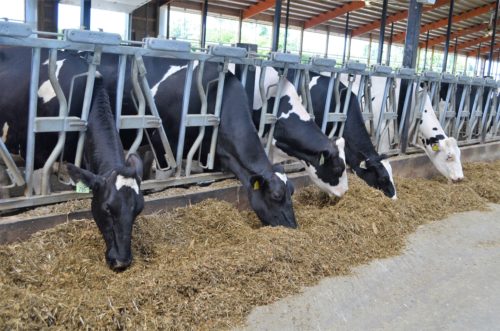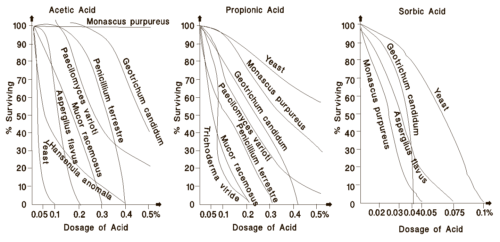Protecting your Feed Investment During Heat Events with TMR Stabilizer
Posted: June 24, 2020 | Written By: Troy Brown, Form-A-Feed Forage Product Manager

Hot, humid weather imposes physiological challenges on lactating dairy cows, leading to lower feed intake, reduced milk production, and lower pregnancy rates. Depressed feed intake during heat events is compounded by yeast and mold growth destroying the nutrients in the total mixed ration (TMR). These nutrients are critical for lactating dairy cows to assure they maintain production, body condition, and healthiness. Strategies can be employed to enhance feed aerobic stability and to reduce the impact of yeast and mold.
Storage and feed-out best management practices:
- Avoid removing excessive cover plastic prior to feed-out.
- Removing cover plastic does present some safety challenges. Consider a safety harnessing system for anyone approaching the edge of the silage face.
- Maintain a smooth feed-out face at all times.
- Proper feed-out face-removal equipment such as mechanical facers or rakes should be considered. This will improve face removal efficiency and the ability to maintain a smooth face.
- Avoid using large equipment with a bucket that can dig into the pile, creating cracks causing excessive air penetration.
- Remove 6 – 12 inches per day in cold weather and at least 12 inches during warm weather.
- Yeast and mold organisms can and will proliferate in cool temperatures, but are much more aggressive in warmer temperatures.
- In very large bunkers and piles this may require “splitting” or taking more than a single cut. This will create a second side face which will cause some feed-out shrink when the second cut is taken.
- Do not remove more feed than what can be mixed and delivered in a 4-hour period of time.
- Do not pile unstable silage for feeding at a later time or date.
- Discard any visibly moldy feed.
How & why TMR nutrients are degraded so easily:
- High yeast populations are ensiled at the time of harvest.
- Once the oxygen has expired in a properly stored environment, the yeast become dormant and fermentation begins.
- Fermentation creates high levels of lactic acid.
- Lactating dairy TMR typically include a high concentration of fermented feeds.
- At feed-out, the yeasts are re-energized by the introduction of oxygen.
- Yeasts are lactate consumers and begin degrading the lactic acid as an energy source very rapidly.
- Excessive heat is produced, creating an unstable, unpalatable feed.
- As the lactic acid is consumed and volatilized, the silage pH rises.
- Molds prefer the higher pH and begin to grow very rapidly.
- The result is massive spoilage.
Preventing nutrient degradation in the feed bunk
Research data indicates that it is more economical to control yeast growth at the storage facility than after the fact at the TMR. That said, there are many situations in which utilizing a bunk life stabilizer does provide a significant return on investment. There are numerous commercial products available today. It is important to choose a product that is formulated with ingredients that control yeast growth. As mentioned above, yeast are lactate consumers. As they consume the lactic acid produced during the fermentation process, the pH in the feed increases. As the pH increases, the molds become more aggressive. Controlling yeast growth indirectly controls mold growth. The chart below indicates which organic acids best control yeast growth in aerobic conditions.
Source: Pelhate, J. (1973) Ann. Technol. Agric. 22: 647-661
TMR Stabilizer is formulated to control yeast growth in TMRs
TMR Stabilizer is a proven blend of organic acids and antioxidants that enhances bunk life by stabilizing the pH in forage.
- Four Organic Acids
-
- Sodium Diacetate (acetic acid)
- Sorbic Acid
- Benzoic Acid
- Propionic Acid
-
- Ethoxyquin – Antioxidant
Key Features:
- Applied in a dry form to assure accurate distribution in TMR mixer.
- Buffered to help prevent metal corrosion.
- Easy to use and does not require special storage.
- Packaged in lined bag to ensure product integrity.
Key Benefits:
- Maintains TMR nutrient density and ensures more nutrition delivered with every bite.
- Prevents TMR heating, keeping feed fresh and palatable.
- Improves dry matter intake during summer heat stress, increasing animal performance.
There are numerous factors that will determine the treatment rate of TMR Stabilizer:
-
- Temperature
- Humidity
- Volume of other high moisture feed ingredients
- Quantity and quality of high moisture by-products
- Corn particle size and moisture
- Mold, yeast, and mycotoxin load
- Bunker or silo face removal rate
- Stability of the feed being mixed into the TMR
- Bunk life expectancy rate (How long does the feed need to remain stable in the feed bunk?)
For example, if silage or high moisture corn is unstable (warm or even hot) at the time of mixing into the TMR, high levels of TMR Stabilizer (4 – 6 lbs. per ton of TMR) may be required to prevent further nutrient degradation in the feed bunk. TMR stabilizer can also be used very successfully for short term use as well. For example, during a significant heat/humid event, it is recommended to treat aggressively at a high rate until cooler, less humid conditions return. The economic impact of treating during such events will extend beyond the event itself, as animal performance is much more stable during the event and after the event as well. The goal of feeding a TMR is to assure the nutrients are available at the time of feeding. Since yeast is common in fermented feeds, it is important to incorporate storage and feed-out best management practices.
Understanding the risk factors leading to aerobic instability allows dairy producers to employ best management practices. If you would like to learn more about adding TMR Stabilizer to your TMR to protect your feed investment, please contact your Form-A-Feed nutrition and production specialist!
